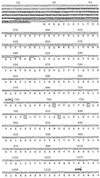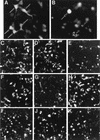Interaction of an adenovirus E3 14.7-kilodalton protein with a novel tumor necrosis factor alpha-inducible cellular protein containing leucine zipper domains
- PMID: 9488477
- PMCID: PMC108875
- DOI: 10.1128/MCB.18.3.1601
Interaction of an adenovirus E3 14.7-kilodalton protein with a novel tumor necrosis factor alpha-inducible cellular protein containing leucine zipper domains
Abstract
Early region 3 (E3) of group C human adenoviruses (Ad) encodes several inhibitors of tumor necrosis factor alpha (TNF-alpha) cytolysis, including an E3 14.7-kDa protein (E3-14.7K) and a heterodimer containing two polypeptides of 10.4 and 14.5 kDa. To understand the mechanism by which the viral proteins inhibit TNF-alpha functions, the E3-14.7K protein was used to screen a HeLa cell cDNA library to search for interacting proteins in the yeast two-hybrid system. A novel protein containing multiple leucine zipper domains without any significant homology with any known protein was identified and has been named FIP-2 (for 14.7K-interacting protein). FIP-2 interacted with E3-14.7K both in vitro and in vivo. It colocalized with Ad E3-14.7K in the cytoplasm, especially near the nuclear membrane, and caused redistribution of the viral protein. FIP-2 by itself does not cause cell death; however, it can reverse the protective effect of E3-14.7K on cell killing induced by overexpression of the intracellular domain of the 55-kDa TNF receptor or by RIP, a death protein involved in the TNF-alpha and Fas apoptosis pathways. Deletion analysis indicates that the reversal effect of FIP-2 depends on its interaction with E3-14.7K. Three major mRNA forms of FIP-2 have been detected in multiple human tissues, and expression of the transcripts was induced by TNF-alpha treatment in a time-dependent manner in two different cell lines. FIP-2 has consensus sequences for several potential posttranslational modifications. These data suggest that FIP-2 is one of the cellular targets for Ad E3-14.7K and that its mechanism of affecting cell death involves the TNF receptor, RIP, or a downstream molecule affected by either of these two molecules.
Figures









Similar articles
-
Immunomodulatory functions encoded by the E3 transcription unit of adenoviruses.Virus Genes. 2000;21(1-2):13-25. Virus Genes. 2000. PMID: 11022786 Review.
-
Interaction of an adenovirus 14.7-kilodalton protein inhibitor of tumor necrosis factor alpha cytolysis with a new member of the GTPase superfamily of signal transducers.J Virol. 1997 Feb;71(2):1576-82. doi: 10.1128/JVI.71.2.1576-1582.1997. J Virol. 1997. PMID: 8995684 Free PMC article.
-
Identification of a cell protein (FIP-3) as a modulator of NF-kappaB activity and as a target of an adenovirus inhibitor of tumor necrosis factor alpha-induced apoptosis.Proc Natl Acad Sci U S A. 1999 Feb 2;96(3):1042-7. doi: 10.1073/pnas.96.3.1042. Proc Natl Acad Sci U S A. 1999. PMID: 9927690 Free PMC article.
-
An adenovirus inhibitor of tumor necrosis factor alpha-induced apoptosis complexes with dynein and a small GTPase.J Virol. 2000 May;74(10):4705-9. doi: 10.1128/jvi.74.10.4705-4709.2000. J Virol. 2000. PMID: 10775608 Free PMC article.
-
Adenovirus region E3 proteins that prevent cytolysis by cytotoxic T cells and tumor necrosis factor.Mol Biol Med. 1989 Oct;6(5):433-52. Mol Biol Med. 1989. PMID: 2533958 Review.
Cited by
-
Inhibition of TNF receptor 1 internalization by adenovirus 14.7K as a novel immune escape mechanism.J Clin Invest. 2006 Nov;116(11):2901-13. doi: 10.1172/JCI23771. Epub 2006 Oct 5. J Clin Invest. 2006. PMID: 17024246 Free PMC article.
-
Immunomodulatory functions encoded by the E3 transcription unit of adenoviruses.Virus Genes. 2000;21(1-2):13-25. Virus Genes. 2000. PMID: 11022786 Review.
-
Optineurin in ocular herpes infection.Exp Eye Res. 2022 Jun;219:109059. doi: 10.1016/j.exer.2022.109059. Epub 2022 Apr 4. Exp Eye Res. 2022. PMID: 35390332 Free PMC article. Review.
-
A Drosophila IkappaB kinase complex required for Relish cleavage and antibacterial immunity.Genes Dev. 2000 Oct 1;14(19):2461-71. doi: 10.1101/gad.817800. Genes Dev. 2000. PMID: 11018014 Free PMC article.
-
Dysfunction of Optineurin in Amyotrophic Lateral Sclerosis and Glaucoma.Front Immunol. 2018 May 23;9:1017. doi: 10.3389/fimmu.2018.01017. eCollection 2018. Front Immunol. 2018. PMID: 29875767 Free PMC article. Review.
References
-
- Beg A A, Baltimore D. An essential role for NF-kappaB in preventing TNF-alpha-induced cell death. Science. 1996;274:782–784. - PubMed
-
- Boldin M P, Goncharov T M, Goltsev Y V, Wallach D. Involvement of MACH, a novel MORT1/FADD-interacting protease, in Fas/APO-1- and TNF receptor-induced cell death. Cell. 1996;85:803–815. - PubMed
-
- Boldin M P, Varfolomeev E E, Pancer Z, Mett I L, Camonis J H, Wallach D. A novel protein that interacts with the death domain of Fas/APO1 contains a sequence motif related to the death domain. J Biol Chem. 1995;270:7795–7798. - PubMed
-
- Boyd J M, Gallo G J, Elangovan B, Houghton A B, Malstrom S, Avery B J, Ebb R G, Subramanian T, Chittenden T, Lutz R J, Chinnadurai G. Bik, a novel death-inducing protein, shares a distinct sequence motif with Bcl-2 family proteins and interacts with viral and cellular survival-promoting proteins. Oncogene. 1995;11:1921–1928. - PubMed
-
- Carlin C R, Tollefson A E, Brady H A, Hoffman B L, Wold W S M. Epidermal growth factor receptor is down-regulated by a 10,400 mw protein encoded by the E3 region of adenovirus. Cell. 1989;57:135–144. - PubMed
Publication types
MeSH terms
Substances
Associated data
- Actions
Grants and funding
LinkOut - more resources
Full Text Sources
Other Literature Sources
Molecular Biology Databases
Research Materials
Miscellaneous
